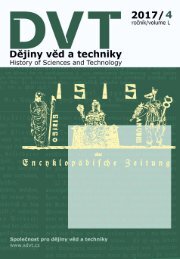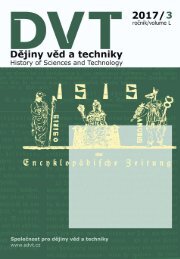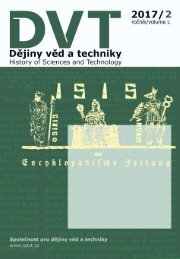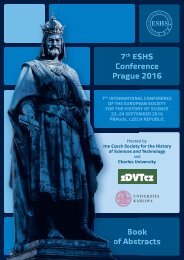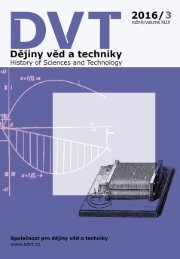Dějiny věd a techniky 2015, 4
Číslo je věnováno 7. mezinárodní konferenci Evropské společnosti pro dějiny vědy, která se konala 22.–24. září 2016 v Praze.
Číslo je věnováno 7. mezinárodní konferenci Evropské společnosti pro dějiny vědy, která se konala 22.–24. září 2016 v Praze.
Create successful ePaper yourself
Turn your PDF publications into a flip-book with our unique Google optimized e-Paper software.
DVT – DĚJINY VĚD A TECHNIKY XLVIII (<strong>2015</strong>), 4<br />
were intensively dealing with linear integral equations. Plemelj published several<br />
papers about the problem, which attracted the attention of the mathematical<br />
community. This is how a door opened for him into the academic world; he<br />
became a private lecturer at the College of Engineering (Technische Hochschule)<br />
in Vienna. The peak of his career is represented by his solution of the so-called<br />
Riemann problem in 1908. He later became an associate and then full professor<br />
at the university in Chernivtsi. Since Plemelj was publicly known as a Slovene<br />
nationalist, and thus spiritually belonged to the new generation of professors,<br />
which, unlike the older generation, did not avoid expressing its national definition,<br />
the process of appointing him an associate and then full professor was quite<br />
lengthy. He was appointed only after the intervention of his professor, Georg<br />
von Escherich, who stressed Plemelj’s international reputation and the possibility<br />
of scandal if he was not chosen. 32<br />
Plemelj had problems because of his clear national definition in 1916 as well,<br />
when the police suspected him of “russophiler Gesinnung” (Russophile attitude),<br />
for which he was interned and put under the watchful eye of the police. He was<br />
then helped by a colleague, who provided him a job in Vienna. After the war,<br />
Plemelj returned to Ljubljana, despite the invitation of the Romanian Government<br />
to continue to lecture at the university in Chernivtsi. Afterwards, he became the<br />
first chancellor of the University of Ljubljana, founded in 1919. However, since<br />
he was not a good organizer, according to his own assessment, he could not<br />
adapt to this position. 33 He was becoming unsatisfied with the situation at the<br />
university, so he considered accepting the offer for a position at the University<br />
of Graz in 1927. But when, in 1928, he was conferred a high state decoration<br />
and promised additional resources by the ministry, he rejected the position in<br />
Graz. 34 In letters to Georg Faber, a German mathematician whom he met<br />
in Göttingen, he lamented over his loneliness in Ljubljana, and wrote about his<br />
awareness that the peak of his career was already behind him. 35<br />
Just the opposite is true for Maks Samec, who, like Plemelj, studied in<br />
Vienna, made the first steps of his academic career there and, after the war,<br />
returned to Ljubljana, where he succeeded. He became a full professor at the<br />
University, and the founder of the Slovene school of chemistry. Samec hoped<br />
that, in this challenging venture, he would be helped by his professor Wolfgang<br />
Pauli, but the university council objected to his appointment explaining they<br />
32<br />
ARS, AS 2012, box 1, no. 1–13.<br />
33<br />
ARS, AS 2012, box 1, no. 12–13.<br />
34<br />
Archives of Yugoslavia, AJ 66, 66-228-230, 1931, no. 4/31.<br />
35<br />
ARS, AS 2012, b. 10, no. 188.<br />
252<br />
Ana Cergol Paradiž – Željko Oset




